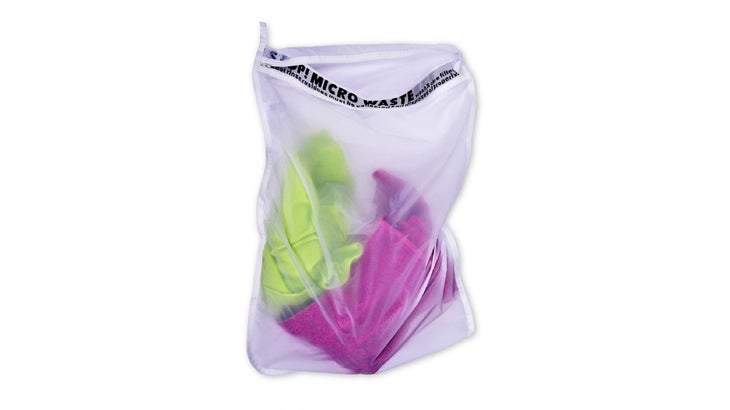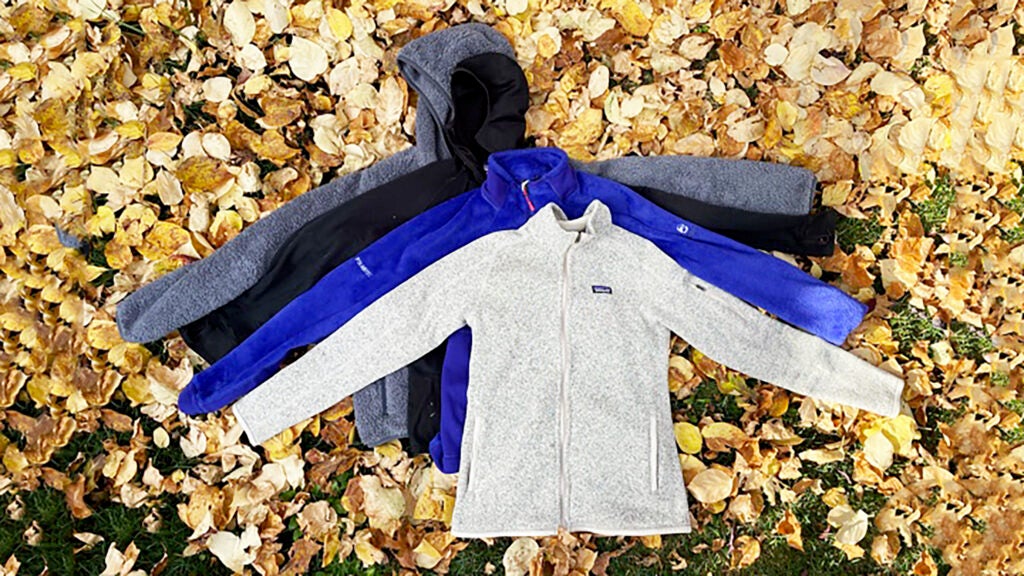No products in the cart.
Outdoor Adventure
How to Reduce Fleece Microfiber Shedding
It’s winter, which, for most outdoors people, means that it’s fleece season. Cozy, comfy fleece season.
Fleece dates back to 1981, when Yvon Chiounard worked with Malden Mills (now Polartec) to create something that felt as warm and cozy as his favorite wool sweater, but that dried quicker and compressed down smaller for backpacking trips. Since then, outdoor adventurers of all sorts have loved their fleece.
I am no exception: I own a hooded, 15-year-old men’s Patagonia R1 that I pilfered from my husband and wear for climbing, winter running, and camping (love pulling the hood on to sleep). I also own a fluffy (high pile) purple zip-up fleece jacket from The North Face that, for almost 20 years, I’ve pulled on during backyard dinners that turn chilly; it feels like a blanket. I invested in a Patagonia Better Sweater Jacket a couple years ago and wear it to outdoor sporting events and around town. And I just recently bought a Patagonia Los Gatos Hooded Jacket that I’m now obsessed with. Talk about cozy. I’m sure I have more tucked into my closet somewhere, and I love them all for their performance abilities and warmth-to-weight ratio.
I may love my fleeces, but, I also love the environment in which I get to wear them. And, lately, I keep seeing studies about the microfibers that shed from fleece and end up in our waterways—making the material seem evil. Should I find and wear alternatives? I wanted to learn more.
I connected with experts at Patagonia, Polartec, and Icebreaker to learn about the problem with fleece, what companies are doing to solve it, and what we as consumers can and should be doing to help mitigate it.
The Problem with Fleece
Fleece comes from synthetic (plastic) materials—that’s what makes them dry quickly. On the plus side, environmentally, most outdoor brands utilize upcycled plastics for their fleece, transforming discarded plastic into usable material. In fact, Polartec has used over two billion post-consumer PET bottles to produce fabrics that are sold to hundreds of brands globally.
Every time you wash a fleece, however, synthetic microfibers shed from the garment and make their way to our waterways, contributing to the massive problem of ocean plastics. And since the fibers are so small, they’ve been found in—gulp—our drinking water. A study funded by Patagonia and conducted by the University of California at Santa Barbara (Go Gauchos! My alma mater) found that synthetic fleece jackets release 1.7 grams of microfibers or as many as 250,000 synthetic fibers each wash. Organisms in the ocean ingest the microfibers, and humans ingest many of those organisms, causing health risks.
Fleece isn’t the only material that sheds (not that this is a good thing). According to Corey Simpson, communications manager for Patagonia, high-quality fleece sheds very small amounts, but lightweight synthetic wovens used in some down and other jackets shed just as much as these fleeces can. “Since fleece looks fuzzy, it tends to be blamed for the only item that sheds,” says Simpson, “but microfibers come from other items as well, including car tires, marine coatings, and personal care products.”
What’s Being Done
Companies like Polartec and Patagonia are pioneering new processes for how fleece is created. Polartec, for example, has installed a customized vacuum and filtering system to capture waste and upcycle it for reuse in other products.
In February 2023, Polartec launched a “Shed Less Fleece” program that combines yarn construction, knitting, chemistry, and manufacturing to reduce home laundry fiber fragment shedding. Karen Beattie, director of product management at Polartec, says, “This test was conducted with large sample sizes to account for variability, and concluded that Shed Less Fleece reduced fiber fragment shedding by an average of 85% compared to the baseline fabric.”
Aside from continuing research on the issue, Patagonia has partnered with Samsung, maker of washing machines and other electronics, to create a laundry cycle that cuts 54% of microplastics emissions with washers using Samsung’s Ecobubble™ technology. The wash cycle generates a “greater amount of bubbles” that “helps the detergent quickly penetrate fabrics and remove dirt, all while saving energy,” according to Samsung.
The two have also partnered to create a filter that can work with a range of washing machine brands and can capture 98% of microfibers shed in the laundry. The filter is currently only available in Europe, Korea, Turkey, and the UK, but it’s projected to be available in the U.S. and Canada in 2024.
What You Can Do
A couple of conscientious businesses trying to find solutions to the exorbitant amount of microplastics that end up in the oceans is fantastic. But, as Simpson says, “This is not an apparel company’s problem. It’s everybody’s problem.”

Here are a few things we can do on an individual level: To capture the microfibers that come off your fleeces and other synthetic garments, you can invest in a Guppyfriend washing bag. The company reports that utilizing the bag results in 86% fewer synthetic fibers coming off your fleeces. The fibers that do shed collect in the corners of the bag and you can then dispose of them in the trash. (Guppyfriend recommends placing microfibers in a closed container when disposing to avoid being blown away…and into waterways.) I just ordered mine: at only $35, it seemed like a no-brainer. More ambitiously, buying and installing a PlanetCare Filter ($63) to existing washing machines can capture up to 90% of the microfibers that come off your clothes.
If you’re going to buy a new fleece, Simpson says that large, established brands that have been selling fleece for a long time have supply chains centered around sustainability and environmentalism. OceanCleanWash.com, an informational website founded by the Plastic Soup Foundation, advises that you should never buy very cheap, generic fleece products. The fibers of these, they say, are extra vulnerable to pulling away from the garment and ending up in waterways. They also recommend donating your old fleeces to minimize demand for new fleeces and also keep old ones out of landfills.
OceanCleanWash.com also lists the following care recommendations to keep the shedding of your fleeces to a minimum:
- Wash infrequently.
- Wash on cold water cycles, with liquid soap and fabric softener.
- Air dry, don’t throw in the dryer, to help them last longer. (Fleece dries quickly; that’s one of its merits for usage in the outdoors.)
One solution is to buy all-natural fleece like Icebreaker’s RealFleece, which is made of Merino wool and comes in zip-up jackets, vests, and pullovers. The downside to fleece made of Merino instead of synthetic materials is that it doesn’t dry as quickly, can be bulkier, and costs more. But natural fibers that shed from these types of fleeces and end up in watersheds are just that: natural, and biodegradable, according to a study conducted by New Zealand’s AgResearch institute, which we can feel better about than shedding microfibers from synthetics.
Should we stop buying fleece? I’m not sure. I do kind of feel badly about my latest purchase—did I really need another fleece? Should I have invested in a wool fleece instead? I’ll be more mindful when I next shop for one, and with the ones I have, I’ll be using my new Guppyfriend wash bag once it arrives. And then I’ll air dry.
Source link

